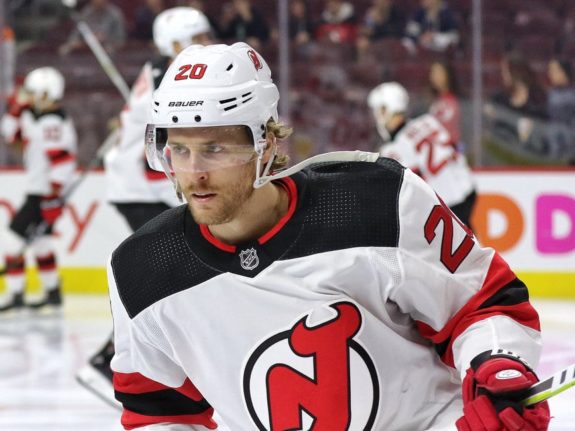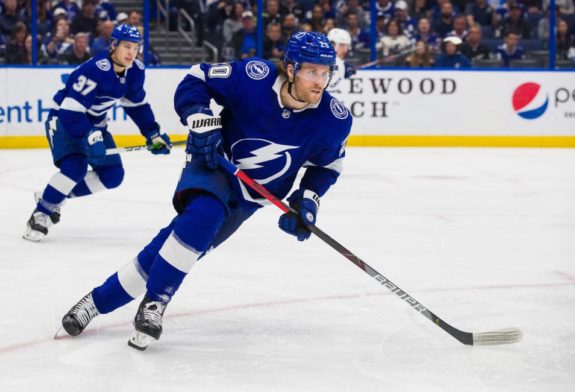For the Tampa Bay Lightning, the 2019-20 season was a make-or-break moment for a franchise that had become known as good enough to make deep runs in the postseason but not good enough to win a Stanley Cup. After the well-documented 2019 Postseason collapse, it became clear that the team would have to find a way to win it all soon, or risk seeing another talented player core torn down after coming up empty-handed one too many times.

Given this atmosphere, Lightning general manager Julien BriseBois decided it was time to go all-in and buff his already impressive roster at the 2020 Trade Deadline. After standing pat with a group that looked unbeatable in 2019, BriseBois took an aggressive approach by cashing in a bevy of Tampa Bay’s picks and prospects in order to bring back players that could make the difference for a Stanley Cup push.
Lightning Acquire Coleman From Devils in Blockbuster Trade
The first major trade by the Lightning occurred on Feb. 16, 2020, when BriseBois shipped 2019 first-round draft pick Nolan Foote and the 2020 first-round pick they acquired in the J.T. Miller deal with the Vancouver Canucks to the New Jersey Devils for forward Blake Coleman. This trade made a lot of sense for Tampa Bay at the moment, even if it cost a premium price.
The reasons why BriseBois coveted Coleman were understandable. He was a solid defensive forward who was on an impressive scoring run for a bad New Jersey team, posting 21 goals and 31 points in 57 games. Not only that, he was being paid below market value at $1.8 million until the 2021 offseason, giving BriseBois a cost-controlled asset that could slot in, conceivably, anywhere in the lineup.
What Coleman Brought to the Lightning
Due to circumstances outside of anyone’s control, it took some time for Coleman to showcase his talents for Tampa Bay. However, once he started playing alongside Yanni Gourde and fellow deadline acquisition Barclay Goodrow in the 2020 Postseason, he became a key cog on one of the most impactful forward lines for the Lightning.
Sure they didn’t score every night, but this line changed the way Tampa Bay played. They were a tenacious force that brought to the ice everything you needed to win in the postseason. For his part, Coleman led the team in hits, took on more than two minutes of playing time short-handed each night, posted the Lightning’s last goal of the playoffs, and scored one of the best goals of the entire postseason.

With one successful postseason run under his belt, Coleman looked to continue his incredible play in the shortened 2020-21 season. In 55 games, he posted 14 goals and 31 points, while continuing to be an absolute pest alongside Gourde and Goodrow.
However, it was the 2021 Playoffs when Coleman once again made his mark on the franchise. In 23 games, he played that perfect energy role to help push the Lightning over the top. While he didn’t score a lot, the few times he hit the back of the net it was impactful, including a last-second goal that helped secure a victory in the Stanley Cup Final.
After winning back-to-back championships with the Lightning, Coleman departed the franchise and signed a well-earned six-year contract with the Calgary Flames paying him roughly $4.9 million per year.
What the Lightning Traded for Coleman
While Coleman’s tenure in Tampa Bay was successful, they didn’t get his services for free. Giving up a top prospect like Nolan Foote (His brother, Cal Foote, plays with the Nashville Predators) and a potential top-15 pick had the chance to backfire dramatically.
You may also like:
- Canadiens Complete Florida Sweep With 5-2 Win Over the Lightning
- Projected Lineups for the Canadiens vs Lightning – 12/29/24
- Lightning Easily Handle Reeling Rangers 6-2
- Hedman Becomes Lightning Franchise Leader in Games Played
- Projected Lineups for the Rangers vs Lightning – 12/28/24
First, let’s discuss Foote, who has been showing solid development since joining New Jersey. In the 2020-21 season, he played in 24 games for the then Devils’ AHL affiliate, the Binghamton Devils, posting seven goals and 17 points. He also got the call to start in six NHL games as well, scoring a goal and an assist.
In 2021-22, Foote continued this strong play for the Utica Comets in the AHL, starting in 37 games and posting eight goals and 22 points along with a plus-18, which was third-best on the team. Given that he is only 23 years old, there is still a lot of time for him to develop his power forward frame and become a top-six monster for New Jersey.
Now for the first-round pick, things could have gone a lot worse for Tampa Bay. The 2019-20 Canucks were a good team that had playoff aspirations despite some stretches of weak play that threatened to pull them out of contention. Despite this, after they went on a run in the 2020 Playoffs and came up just short of the Western Conference Final, this pick settled in at 20th overall for New Jersey.
With their third selection in the 2020 first round, the Devils took a bit of a risk on defenseman Shakir Mukhamadullin. While some scouts saw Mukhamadullin as a sure-fire first-rounder, others had him going in the early third at best. However, as a 22-year-old with a 6-foot-4 frame and a path to take on big minutes in the Kontinental Hockey League (KHL), it’s easy to see why New Jersey took the chance on him.
Since being selected, Mukhamadullin has been a good player, taking on 39 games in 2020-21 and 34 games in 2021-22 for Ufa Salavat Yulaev. While his scoring numbers aren’t exceptional, he showed the development path for a player who made the jump to North America in subsequent; however, it wasn’t with the Devils as he was traded to the San Jose Sharks at the 2023 NHL Trade Deadline. He made his NHL debut with the Sharks on Jan. 27, 2024.
Who Won the Coleman Trade?
While it is always fun to discuss who won or lost a big trade in the moment, it often takes months or even years to fully understand the impact of these deals. If you’re a fan of the Lightning, the trade for Coleman was a clear win, as he played a key role in back-to-back championship runs. Depending on how you look at it, you can make the argument that this is one of if not the best deadline deals in franchise history.
On the other hand, if you’re a fan of the Devils, you can also make the argument that they won this trade. The team cashed out a prime asset at peak value, returning a top prospect and a first-round pick. This was no small return, and smart moves like this that can help kickstart a rebuild.
Read Also: Legendary Players, Weird Jerseys
In the end, if both teams can look at a trade positively, that means there likely isn’t a true winner. The Lightning got a piece that they needed, and the Devils got assets to help them rebuild for the future, making this a rare deadline win-win.
